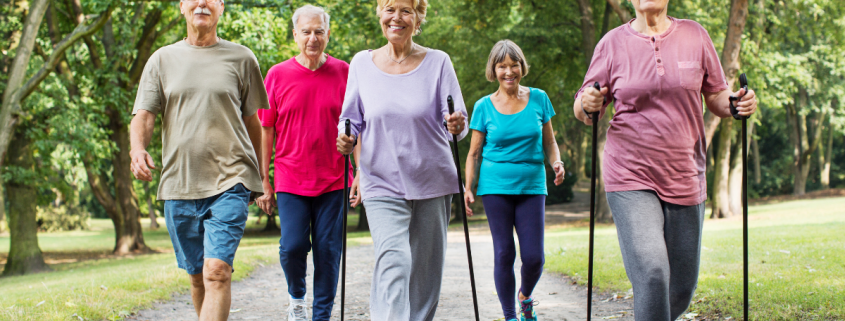Walking Guide for Seniors: Safety, Gear, and Techniques
Walking is a fantastic activity for seniors to maintain physical activity and lead a healthy lifestyle. This straightforward exercise provides numerous physical and mental advantages, such as boosting heart health and lifting spirits. To fully benefit while reducing risks, it’s crucial to grasp the fundamentals of safe and effective walking. Below is a detailed guide to walking for seniors, encompassing crucial safety tips, recommended walking routes, and essential gear.
Safety Tips for Walking
Proper footwear is crucial for safe walking. Shoes should have excellent arch support, cushioning, and a firm grip to maintain balance and reduce impact on your joints. Ensure your feet have plenty of room in the toe box and avoid worn-out soles that can lead to discomfort or injury. Proper footwear will help keep you comfortable and injury-free.
Visibility is also vital to safety, especially during dawn, dusk, or nighttime. Bright, reflective clothing or accessories can make you more noticeable to drivers and pedestrians. Consider wearing a lightweight reflective vest, LED armbands, or a headlamp to illuminate your path and increase your visibility to others. Reflective tape can also be added to walking sticks or shoes for extra safety.
Staying hydrated is essential, particularly on warm days. Bring a water bottle and sip it regularly before, during, and after your walk. Proper hydration will help prevent fatigue and joint stiffness. Consider taking an electrolyte drink for longer walks to replenish lost minerals and keep your energy up.
Lastly, warming up before your walk and cooling down afterwards can help prevent injuries and muscle soreness. Before setting out, gently stretch or slow movements to warm up your muscles. Afterwards, cool down with simple stretches like calf or ankle rolls to promote flexibility and avoid stiffness.
By following these safety tips, you can make your walking routine safer and more enjoyable while minimising the risk of injury.
Suitable Walking Gear
The right walking gear ensures a safe and enjoyable experience, helping you stay comfortable and motivated. Here are some essential items to consider before setting out on your next walk:
- Walking Shoes: Look for shoes with cushioned soles for impact absorption, substantial arch support for stability, and non-slip outsoles for secure footing. Many brands offer senior-friendly designs, including extra padding and easy fastenings like Velcro straps or slip-ons.
- Walking Sticks: Walking sticks or trekking poles can enhance balance and stability, particularly on uneven ground. These adjustable sticks can be customised to fit your stride length and usually come equipped with ergonomic handles and wrist straps to ensure a comfortable and secure hold.
- Clothing: Wear weather-appropriate clothing for comfort and breathability. In warm weather, lightweight, moisture-wicking fabrics help keep you cool. In cooler climates, layer with a moisture-wicking base, an insulating layer, and a windproof jacket for warmth.
- Pedometers and Trackers: Pedometers and fitness trackers help track your steps, heart rate, and calorie expenditure, offering crucial insights into your fitness journey. With functionalities like GPS tracking and daily step targets, these devices are good for maintaining your motivation.
Walking Techniques and Exercises
Maintaining proper posture and stride is crucial for effective walking. Stand upright with your head high and shoulders relaxed to reduce strain on your spine and improve alignment. Let your arms swing naturally, taking short, steady steps to maintain balance and rhythm while reducing the impact on your joints. This simple yet mindful approach will make your walk more comfortable and enjoyable.
Integrating balance and mobility exercises can significantly boost your stability and flexibility, minimising injury risks. Doing gentle stretches such as heel-to-toe steps and single-leg stands before and after walking enhances coordination. Performing ankle rotations can also prepare your lower legs for different terrains. Additionally, practising deep, rhythmic breathing during your walks helps keep you energised. By breathing deeply through your nose and out through your mouth, you ensure sufficient oxygen intake, keep a steady pace, and reduce fatigue.
Walking Routes and Trails
Whether you enjoy the serene trails of nature reserves or the vibrant routes of urban neighbourhoods, finding the right walking path can make all the difference. Here, we will explore the various trails available and discuss how to assess terrain and difficulty, ensuring you find a path that perfectly suits your fitness level.
- Scenic Trails: Local parks, nature reserves, and protected wildlife areas often feature serene walking trails that are relaxing and visually engaging. Gentle, scenic paths through lush greenery, along rivers, or through colourful gardens offer a peaceful setting that can transform your walk into a rejuvenating experience. Many of these trails are designed to accommodate different fitness levels and have guide maps or information signs to enrich your journey.
- Urban Routes: Urban walking routes can be just as enjoyable. Explore neighbourhoods with historical landmarks, wide sidewalks, and public art. Prioritise routes with even surfaces, benches for breaks, and well-lit streets to ensure a safe and comfortable walk. You can also follow popular walking paths through plazas, waterfronts, or cultural districts to add variety to your urban exploration.
- Trail Difficulty: Assess the terrain and difficulty level before choosing a trail. Review maps or ask locals to understand the accessibility and incline of a particular route. Flat, paved paths are ideal for beginners or those with limited mobility. For experienced walkers seeking a challenge, mild inclines, forested paths, or hilly landscapes can offer a more demanding yet rewarding workout while providing impressive views.
Indoor Walking
When weather conditions or accessibility issues arise, indoor walking offers practical alternatives that can be just as rewarding. Here are some indoor options to consider:
- Mall Walking: Shopping malls provide a safe, climate-controlled environment for walking, with smooth floors and rest areas for comfort. While taking laps around the mall, you may find camaraderie with other seniors enjoying the same benefits.
- Treadmills or Indoor Tracks: When the weather isn’t ideal, using a treadmill or finding a local gym with an indoor walking track can keep you active. Both options offer steady, reliable surfaces with adjustable speed.
- Video-Guided Workouts: Video-guided walking workouts can bring the outdoors to you. These workouts, which can be done at home, offer virtual routes and engaging scenery to keep your indoor exercise exciting and motivating.
Conclusion
Walking is an adaptable and accessible activity that provides incredible benefits for seniors. With proper safety measures, suitable gear, and intelligent techniques, seniors can confidently embark on their walking journey, whether it’s a nature trail, a bustling city route, or a cosy indoor track. Listen to your body, prioritise comfort, and enjoy each step!
To discover more tips and resources, visit our website. Stay safe, keep moving, and enjoy your walks!















